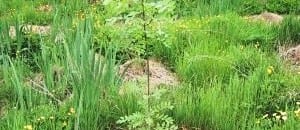
Vegetation Control
Competing vegetation is major problem in establishing forests in Ireland. The mild moist climate is favourable for the lush growth of grasses and herbaceous plants that compete for light, moisture and nutrients with the newly planted trees. This competition lasts for 2-3 growing seasons by which time the plants have generally grown above the vegetation. While mounding (commonly used cultivation method) can help to reduce the effects of competition some form of vegetation control is usually necessary on most sites and this is carried out manually or by the use of chemical herbicides.
Manual vegetation control
This is traditional method of maintaining the plants free from weed competition. A small scythe or hook is used to cut the vegetation around the plant. Alternatively, with tall grassy vegetation it is often sufficient to trample the area around the trees as the weeds, when flattened, remain on the ground.
Manual weed control is labour intensive and therefore a costly operation. Depending on the site and weather conditions, it is sometimes necessary to clean a plantation twice in the same year. Manual control is generally not used much these days as permanent forest staffs dwindle and most operations are carried out by contractors. Chemical control also is more effective and less costly.
Chemical vegetation control
Herbicides have proven to be the most cost effective means of controlling weeds in plantations and consequently are the most commonly used method of weed control.
While the use of chemical pesticides is controversial in forestry, only those approved by the Pesticide Control Service of the Department of Agriculture can legally be used. In forests certified to the FSC Standard, only those pesticides approved by the FSC can be used.

Controlling competing vegetation ensures good survival and early rapid growth ( photo S. Meyen)
Herbicides are used sparingly and only where they are necessary. There is no advantage in spraying vegetation that is not competing with the trees as this practice is both ineffective and costly. Spot spraying immediately around the plants or band spraying along a row of trees is normal practice. Aerial spraying of herbicides (or other pesticides) is not practiced in Ireland.
Depending on site fertility, plantations with fast growing species generally receive only 2 – 3 applications of herbicides during a 40 year rotation. In the case of broadleaves 4-5 applications may be necessary for the slower growing species such as oak or beech which have a rotation of 100-150 years. The use of herbicides in forestry is therefore minimal when compared with agriculture or even domestic use in gardens where annual applications are made.
All operators that are engaged in spraying pesticides are required to be fully trained in the safe handling and use of chemical pesticides (herbicides, insecticides and fungicides). They are also required to use protective clothing when handling and spraying chemicals and must follow best practice as detailed in the Guidelines for the Use of Herbicides in Forestry, the Forest Protection Guidelines, the Forestry and Water Guidelines and the Forest Biodiversity Guidelines, published by the Forest Service.
Operators are required to take great care when spraying plantations near aquatic or other sensitive sites (biodiversity areas) as drift can cause non-target areas to be treated.
Forest Certification promotes the development and adoption of environmentally friendly non-chemical methods of pest management and strives to avoid the use of chemical pesticides. Both the FSC and PEFC forestry standards for Ireland require that the forest manager/owner must justify the usage and reasons for not using non-chemical methods. Where pesticides are used, they are required to be used in minimum effective quantities, and with strict observation of controls and regulations relating to their use.
